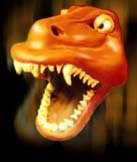Scientists find gigantic dinosaurs -predators may have hunted in packs
Fossil hunters in Patagonia have unearthed the remains of more than a half-dozen gigantic dinosaurs that appear to have lived and hunted in a pack.

Mapusaurus roseae was bigger than Tyrannosaurus rex and may be the biggest carnivorous dinosaur in history, said University of Alberta paleontologist Philip Currie, a member of the team that made the discovery. More than 12.5 metres in length, it had a head the size of a bathtub and teeth like daggers.
Alone, however, it didn't stand a chance of killing the colossal plant-eaters that also lived 100 million years ago in South America, including Argentinosaurus, which was as tall as a six-storey building and the biggest dinosaur in history. But a Mapusaurus pack, working together, could have taken one out, Dr. Currie said, repots The Globe and Mail.
According to Seattle Times, Currie said the Argentine site had the remains of at least seven animals from 18 feet to 40 feet long, suggesting they may have been a herd or family in which different group members could provide either speed or strength.
"It's certainly an intriguing idea," said paleontologist Peter Makovicky, of Chicago's Field Museum. "The problem, though, is that when you have only one incidence you really don't know what's going on."
Reporting in the current issue of the French journal Geodiversitas, Currie and Rodolfo Coria, of the Museo Carmen Funes, in Plaza Huincul, Argentina, named the new animal Mapusaurus roseae.
Currie said the researchers found hundreds of bones in a sandstone deposit. He said the fossils were 100 million years old, and appeared to have been carried away by a flash flood.
"The river was running very fast when they were buried in it," Currie said. "It was a single event in a short amount of time." He said the deposit did not contain the bones of any other species of dinosaur, a rare occurrence for meat-eaters.
The palaeontologists suspect that even deadly 6-tonne predators could benefit from living and hunting in packs, if it helped them bring down those enormous plant-eaters.
"Argentinasaurus is a good prey candidate," says Coria, because its remains are the same age as Mapusaurus. With a monstrously long neck and tail, a fully-grown Argentinasaurus weighed in at about 100 tonnes, making it the biggest known land animal of all time. A single Mapusaurus might have bagged a juvenile, but "you would need a pack of them to take down an adult Argentinasaurus", says Tom Holtz at the University of Maryland in College Park, US.
None of the other predators that lived near the time of Mapusaurus have been found in groups, although that may be because their fossils are rare. Tyrannosaurs may have been an exception – Currie is studying a bone bed containing several – but no prey as large as Argentinasaurus lived in that environment, reports New Scientist.
O.Ch.
Subscribe to Pravda.Ru Telegram channel, Facebook, RSS!


